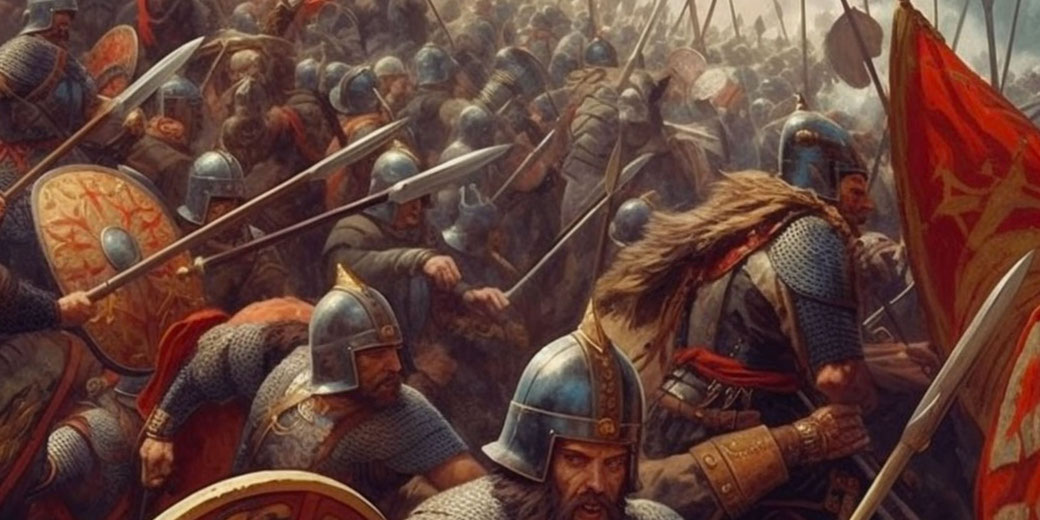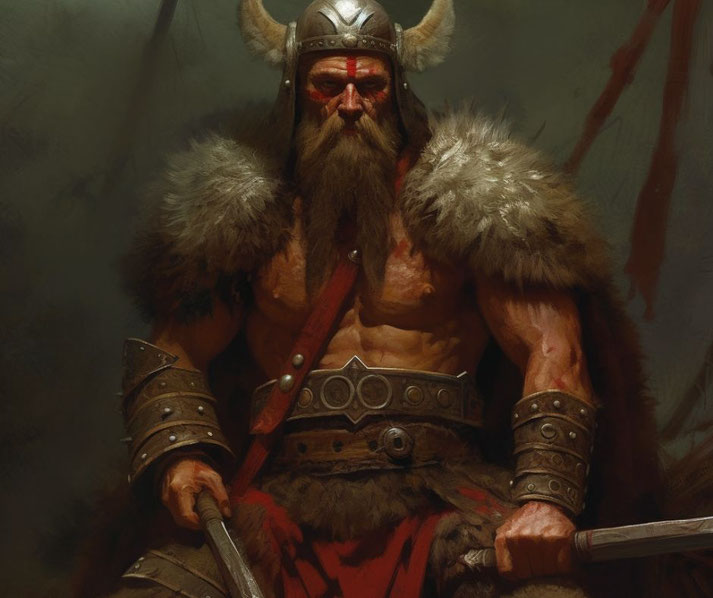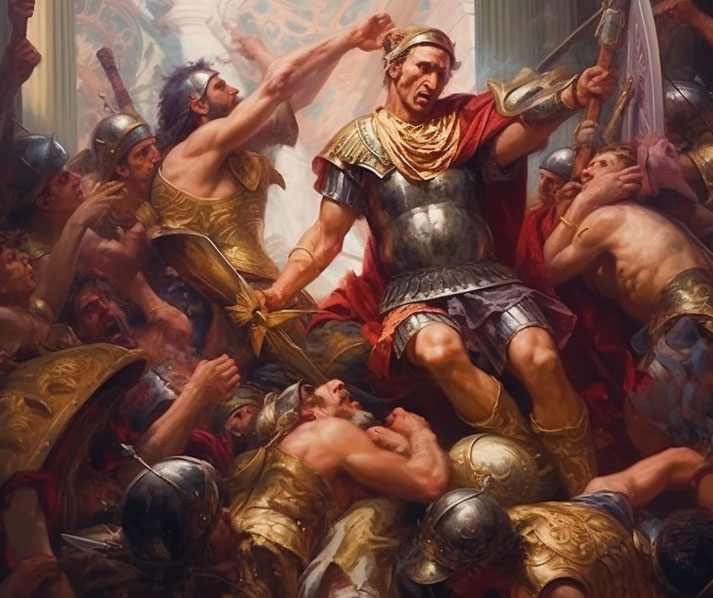The disastrous Battle of Adrianople: The beginning of the end for the Roman Empire

The Battle of Adrianople, fought on August 9, 378 AD, stands as one of the most significant and consequential military encounters in the history of the Roman Empire.
Its impact resonated far beyond the battlefield, sending shockwaves through the political and social structures of the time and forever altering the trajectory of Western civilization.
At its core, the Battle of Adrianople was a confrontation between the Eastern Roman Empire, led by Emperor Valens, and a coalition of Gothic rebels, commanded by the Gothic chieftain, Fritigern.
The confrontation, however, was more than just a power struggle. It represented a clash of cultures, political ideologies, and military tactics.
This was a moment when the resilience of the Goths collided with the might of the Roman legions, culminating in a battle of such magnitude that it would reshape the future of Europe.
An empire in crisis
The late 4th century was a time of significant turmoil and change for the Roman Empire.
Divided between East and West since Emperor Diocletian's tetrarchy, the Empire was grappling with internal strife, external threats, and an evolving political landscape.
At this time, the Roman Empire was the preeminent power in Europe, its vast territories extending from the British Isles to the Middle East.
Yet, this remarkable expanse brought with it enormous challenges, especially along the Empire's extensive borders.
One of these borders, the Danube, was of particular concern due to the migrations of various Germanic tribes, among them, the Goths.
The Goths, a collective term for several Germanic tribes, were initially divided into two main groups: the Visigoths and the Ostrogoths.
In the mid-fourth century, pressured by the westward expansion of the Huns from Central Asia, the Goths sought refuge in the Roman Empire.
They were allowed to cross the Danube and settle in the Eastern Roman Empire's provinces in 376 AD under certain conditions, including supplying soldiers for the Roman army.
However, mismanagement, corruption, and abuse by local Roman officials led to severe mistreatment of the Goths, resulting in an uprising known as the Gothic War.
At the helm of this rebellion was Fritigern, a Visigothic leader who deftly united various Gothic tribes and other 'barbarian' allies under a common cause.

Causes of the battle
These tensions came to a head in the late 4th century AD, sparking a chain of events that would ultimately lead to the catastrophic clash at Adrianople.
One of the primary causes was the mass migration of the Goths into the Eastern Roman Empire.
In 376 AD, displaced by the advancing Huns, the Goths sought refuge across the Danube River, appealing to the Romans for asylum.
The Roman Empire, seeing a strategic opportunity to bolster their ranks with Gothic soldiers, granted them entry.
However, the integration process was fraught with difficulties. The Goths were mistreated by Roman officials, subjected to corrupt practices, starvation, and even enslaved under the guise of military recruitment.
These harsh conditions ignited a powder keg of resentment among the Gothic settlers.
Simultaneously, the Roman Empire, despite its territorial vastness and military might, was struggling with internal problems.
Economic issues, political infighting, and a military stretched thin by conflicts on various frontiers had weakened the Empire from within. Emperor Valens, ruling the Eastern half of the Empire, was engrossed in a war with Persia, thereby leaving the Gothic issue inadequately addressed.
Under these conditions, the Goths, led by Fritigern, rebelled against their Roman overlords.
This uprising, known as the Gothic War, led to a series of engagements between the Romans and the Goths.
In response to the escalating crisis, Emperor Valens decided to personally lead a campaign against the rebels, a decision that would culminate in the confrontation at Adrianople.
The dramatic differences between the two leaders
The Battle of Adrianople was not just a collision of two armies; it was a confrontation between two formidable leaders, each representing vastly different cultures and military traditions.
The two key figures in this historical narrative were Emperor Valens of the Eastern Roman Empire and Fritigern, the leader of the Gothic forces.
Flavius Julius Valens, the younger brother of Emperor Valentinian I, was the Roman Emperor from 364 to 378 AD.
Upon Valentinian's ascension, he divided the Roman Empire into Eastern and Western halves, with Valens taking the throne of the East.
Valens, despite lacking military experience, had proven himself an effective administrator and ruler.
He was known for his Arian Christian faith, fiscal conservatism, and efforts to consolidate and strengthen the eastern half of the Roman Empire.
However, he was often criticized for his reliance on advisors, some of whom were corrupt or incompetent.
His decision to engage the Goths at Adrianople, despite being outnumbered and without the support of his western co-emperor Gratian, would prove to be a fatal miscalculation.
Fritigern was a leader of the Thervingi Goths, one of the two main Gothic groups who crossed the Danube in 376 AD.
Though less is known about him compared to his Roman adversary, Fritigern was recognized for his leadership skills and military acumen.
He emerged as the unifying figure amidst the fragmented Gothic tribes, presenting a united front against Roman oppression.
His ability to form alliances with other 'barbarian' groups and to skillfully maneuver his forces against the mighty Roman legions spoke volumes about his tactical intelligence.
Fritigern masterfully exploited the vulnerabilities of the Roman forces at Adrianople, leading to a victory that would cement his legacy in history.
How the Battle of Adrianople unfolded
The Battle of Adrianople, fought on August 9, 378 AD, was a spectacle of strategy, valor, and unexpected turns.
It began with the Eastern Roman Emperor Valens marching his army towards Adrianople, where the Goths, under Fritigern's command, had set up camp.
Emperor Valens, despite receiving advice to wait for reinforcements from the Western Emperor Gratian, decided to engage the Goths.
Historians speculate that this decision was driven by a combination of overconfidence, a desire to claim victory before Gratian's arrival, and underestimating the size and strength of the Gothic forces.
As the Roman legions approached the Gothic wagon-fort, Fritigern requested a truce for negotiations, buying time for the rest of his forces, which were out foraging, to return.
Meanwhile, the Roman forces, tired from the march and the summer heat, were getting impatient.
As the afternoon wore on, skirmishes broke out between the two sides, escalating quickly into a full-scale battle.
The Roman infantry launched an assault on the Gothic wagon-fort, but the attack was disorganized and lacked the support of the Roman cavalry, which had been sent to deal with a contingent of Gothic cavalry.
The turning point came when the Gothic cavalry, having dealt with the Roman horsemen, returned to the battlefield.
They attacked the Roman infantry from the rear, causing panic and disorder in the Roman ranks.
The tightly packed Roman soldiers found it difficult to maneuver, and their numerical advantage was nullified.
Emperor Valens, who had been commanding from the rear, was killed in the ensuing chaos.
The exact circumstances of his death remain a mystery, but his demise marked a pivotal moment in the battle and, indeed, in the history of the Roman Empire.
The Battle of Adrianople ended with a resounding victory for the Goths. The Roman forces were decimated, with two-thirds of the army, including many senior officers, losing their lives.
It was one of the most disastrous defeats in Roman history, with long-term implications for the Empire's prestige, morale, and military strength.

The panicked fall-out from the battle
The Battle of Adrianople had immediate and far-reaching consequences for both the Romans and the Goths.
This epic confrontation did more than just determine the victor of a single battle; it changed the course of history for these two civilizations and the wider European continent.
For the Roman Empire, the immediate aftermath was devastating. The loss of Emperor Valens, along with an estimated two-thirds of the Eastern Roman army, was a catastrophic blow to Roman military might and imperial prestige.
The battle marked the deadliest defeat of a Roman army since the Battle of Cannae over six centuries earlier.
The Eastern Roman Empire found itself vulnerable, its borders unprotected and its military command structure severely weakened.
The void left by Valens' death was filled by Theodosius I, who was appointed Emperor of the Eastern Roman Empire by Gratian, the Western Emperor, in the following year.
Theodosius, however, was left with a diminished and demoralized military force and a looming Gothic presence within his borders.
He eventually settled for peace, granting the Goths the status of foederati, semi-independent allies of Rome who were allowed to settle within the empire's borders in return for military service.
This was a marked departure from previous Roman policy and was a sign of the shifting power dynamics.
On the other hand, for the Goths, their victory was a significant morale booster and a validation of their military capabilities.
They had not only survived their confrontation with the formidable Roman army but had also defeated it.
This victory bolstered their confidence and solidified their unity, laying the groundwork for their transformation from scattered tribes into a formidable force in European politics.
The Battle of Adrianople marked the beginning of the end of the Roman Empire. It signaled the decline of Roman military supremacy and exposed the vulnerabilities of the once invincible empire.
Meanwhile, it elevated the status of the 'barbarian' tribes, paving the way for their increased influence and eventual role in the fall of the Western Roman Empire just over a century later.
In these ways, the aftermath of Adrianople reverberated far beyond the battlefield, altering the trajectory of Western history.
What do you need help with?
Download ready-to-use digital learning resources
Copyright © History Skills 2014-2024.
Contact via email
With the exception of links to external sites, some historical sources and extracts from specific publications, all content on this website is copyrighted by History Skills. This content may not be copied, republished or redistributed without written permission from the website creator. Please use the Contact page to obtain relevant permission.





